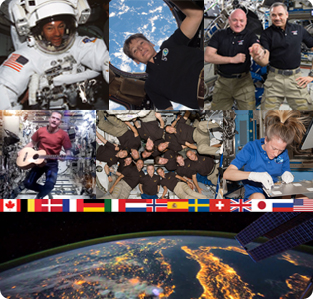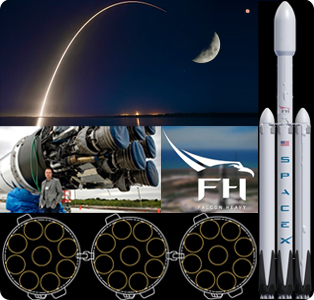Beginning 18th Year of Continuous, Peaceful International Human Presence at ISS
|
MONDAY Ongoing…
|

![]() = All times
= All times
for terrestrial events in local time unless noted.
![]() = All times for international terrestrial events in local time unless noted.
= All times for international terrestrial events in local time unless noted.
![]() = All times for space events, and…
= All times for space events, and…
![]() = All times for international space / astro events in Hawaii Standard Time unless noted. Add 10 hours to obtain UT (‘Universal Time;’ Greenwich, England).
= All times for international space / astro events in Hawaii Standard Time unless noted. Add 10 hours to obtain UT (‘Universal Time;’ Greenwich, England).
Weekly Planet Watch – Evening Planets: Saturn (SW), Uranus (E), Neptune (SE); Morning Planets: Mars (E), Venus (E).
SpaceX to Launch Falcon Heavy on Demo Flight in November
The world’s most powerful rocket is expected to roar on to the world stage this coming month. A specific date is yet to be announced, but all indications are go from Kennedy Space Center launch pad 39A. Falcon Heavy offers the potential for human missions to the Moon and Mars with the capability of lifting over 54 tons into orbit, which doubles the payload of the next closest operational vehicle Delta IV Heavy at less than one-quarter the cost, or US$90M. The in-house fabricated composite fairing is 13.1 meters high and 5.2 meters wide. Generating 22,819 kilonewtons of thrust at liftoff the first stage is composed of 27 Merlin engines arranged in 3 cores. Elon Musk tweeted earlier this year that considerations were being made to perform a powered return and landing of the upper stage during the demo flight. Another demonstration flight is scheduled for 2018 carrying a USAF payload. The first commercial GTO mission is Arabsat, also scheduled for 2018. The 70-m tall rocket with mass of over 1.4M kg is rated to carry a 3,500 kg payload to Pluto. (Image Credit: SpaceX) |
Continued from…
TUESDAY
|
![]() Oct 31 — Lunar and Planetary Laboratory, University of Arizona, Tucson AZ: Colloquium: Characterizing the Diversity of Extrasolar Atmospheres – From Planets to Brown Dwarfs; Michael Line, Assistant Professor at ASU.
Oct 31 — Lunar and Planetary Laboratory, University of Arizona, Tucson AZ: Colloquium: Characterizing the Diversity of Extrasolar Atmospheres – From Planets to Brown Dwarfs; Michael Line, Assistant Professor at ASU.
![]() Oct 31 – Nov 1 — Johnson Space Center, NASA, Lunar and Planetary Institute, Houston TX: Second Hands-on Training in Handling and Manipulation of Small Extraterrestrial Samples.
Oct 31 – Nov 1 — Johnson Space Center, NASA, Lunar and Planetary Institute, Houston TX: Second Hands-on Training in Handling and Manipulation of Small Extraterrestrial Samples.
![]() Oct 31 – Nov 3 — Keck Institute for Space Studies, Caltech, Pasadena CA: Workshop: Cryogenic Comet (and Centaur) Sample Return – Compelling New Science vs. Technological Challenges – Part II.
Oct 31 – Nov 3 — Keck Institute for Space Studies, Caltech, Pasadena CA: Workshop: Cryogenic Comet (and Centaur) Sample Return – Compelling New Science vs. Technological Challenges – Part II.
![]() Oct 31 — Apollo Asteroid 2017 UO2: Near-Earth Flyby (0.028 AU).
Oct 31 — Apollo Asteroid 2017 UO2: Near-Earth Flyby (0.028 AU).
![]() Oct 31 — Apollo Asteroid 2003 UV11: Near-Earth Flyby (0.038 AU).
Oct 31 — Apollo Asteroid 2003 UV11: Near-Earth Flyby (0.038 AU).
![]() Oct 31 — Apollo Asteroid 2017 TZ4: Near-Earth Flyby (0.049 AU).
Oct 31 — Apollo Asteroid 2017 TZ4: Near-Earth Flyby (0.049 AU).
![]() Oct 31 — Amor Asteroid 2017 UO1: Near-Earth Flyby (0.066 AU).
Oct 31 — Amor Asteroid 2017 UO1: Near-Earth Flyby (0.066 AU).
WEDNESDAY
![]() NET Nov — SpaceX, Launch Falcon Heavy Demo, Cape Canaveral AFS FL: SpaceX maiden falcon heavy to launch this month; rocket consists of standard Falcon 9 rocket core with two additional strap-on boosters (total of 27 Merlin engines).
NET Nov — SpaceX, Launch Falcon Heavy Demo, Cape Canaveral AFS FL: SpaceX maiden falcon heavy to launch this month; rocket consists of standard Falcon 9 rocket core with two additional strap-on boosters (total of 27 Merlin engines).
![]() NET Nov – Apr 2018 — CNSA, Tiangong-1 Earth Atmosphere Reentry, LEO: China 1st Space Lab to be disintegrated during Earth atmosphere reentry after slow orbit decay beginning March 16, 2016; predicted to reenter between 43°N and 43°S latitudes during this time frame.
NET Nov – Apr 2018 — CNSA, Tiangong-1 Earth Atmosphere Reentry, LEO: China 1st Space Lab to be disintegrated during Earth atmosphere reentry after slow orbit decay beginning March 16, 2016; predicted to reenter between 43°N and 43°S latitudes during this time frame.
![]() Nov 1 — Deep Space, Kuiper Belt Trajectory: New Horizons spacecraft heading to 2014 MU69 is highlighted in 4-minute video including Pluto flyby; update on distance to KBO, mission elapse time and days until encounter.
Nov 1 — Deep Space, Kuiper Belt Trajectory: New Horizons spacecraft heading to 2014 MU69 is highlighted in 4-minute video including Pluto flyby; update on distance to KBO, mission elapse time and days until encounter.
![]() Nov 1 — Lunar and Planetary Laboratory, University of Arizona, Tucson AZ: Lecture: Are There Unseen Planets Lurking in the Kuiper Belt? by Kathryn Volk of LPL.
Nov 1 — Lunar and Planetary Laboratory, University of Arizona, Tucson AZ: Lecture: Are There Unseen Planets Lurking in the Kuiper Belt? by Kathryn Volk of LPL.
![]() Nov 1-2 — Lunar and Planetary Institute, USRA, Houston TX: The Europa Deep Dive 1: Ice-Shell Exchange Processes Workshop; first in a series of workshops to examine Europa geology, ocean, interior, ice shell, composition, space environment, astrobiological potential.
Nov 1-2 — Lunar and Planetary Institute, USRA, Houston TX: The Europa Deep Dive 1: Ice-Shell Exchange Processes Workshop; first in a series of workshops to examine Europa geology, ocean, interior, ice shell, composition, space environment, astrobiological potential.
![]() Nov 1-2 — Space Studies Board of the National Academies, Irvine CA: Space Studies Board Meeting.
Nov 1-2 — Space Studies Board of the National Academies, Irvine CA: Space Studies Board Meeting.
![]() Nov 1-3 — Canadian Science Policy Centre, Ottawa, Ontario, Canada: 9th Canadian Science Policy Conference 2017.
Nov 1-3 — Canadian Science Policy Centre, Ottawa, Ontario, Canada: 9th Canadian Science Policy Conference 2017.
THURSDAY
![]() Nov 2 — International Space Station, LEO: Today marks beginning of 18th year of continuous Human occupation of ISS; first component launched Nov 20, 1998, occupation began Nov 2, 2000.
Nov 2 — International Space Station, LEO: Today marks beginning of 18th year of continuous Human occupation of ISS; first component launched Nov 20, 1998, occupation began Nov 2, 2000.
![]() Nov 2 — Library of Congress Science, Technology and Business Division, Washington DC: Lecture: To Explore Strange New Worlds…NASA’s Small Steps and Giant Leaps in Understanding Worlds Beyond; Padi Boyd, NASA.
Nov 2 — Library of Congress Science, Technology and Business Division, Washington DC: Lecture: To Explore Strange New Worlds…NASA’s Small Steps and Giant Leaps in Understanding Worlds Beyond; Padi Boyd, NASA.
![]() Nov 2 — Moon: 4.0° SSE of Uranus, 17:00.
Nov 2 — Moon: 4.0° SSE of Uranus, 17:00.
![]() Nov 2 — Venus: 3.5° NNE of Spica, 08:00.
Nov 2 — Venus: 3.5° NNE of Spica, 08:00.
![]() Nov 2 — Apollo Asteroid 496816 (1989 UP): Near-Earth Flyby (0.055 AU).
Nov 2 — Apollo Asteroid 496816 (1989 UP): Near-Earth Flyby (0.055 AU).
FRIDAY
![]() Nov 3 — National Radio Astronomy Observatory, Associated Universities Inc., Socorro NM: 2017 Jansky Lecturer: Dr. Bernard Fanaroff speaks on Observing the Universe from Africa: Linking Radio Astronomy and Development.
Nov 3 — National Radio Astronomy Observatory, Associated Universities Inc., Socorro NM: 2017 Jansky Lecturer: Dr. Bernard Fanaroff speaks on Observing the Universe from Africa: Linking Radio Astronomy and Development.
![]() Nov 3 — Space Center Houston, Houston TX: Lunch with an Astronaut, John-David Bartoe, adult US$69.95.
Nov 3 — Space Center Houston, Houston TX: Lunch with an Astronaut, John-David Bartoe, adult US$69.95.
![]() Nov 3-4 — Adler Planetarium, Chicago IL: Kavli Fulldome Lecture Series: Are we Alone in the Universe?; presented by Lisa Kaltenegger, Director of the Carl Sagan Institute at Cornell University.
Nov 3-4 — Adler Planetarium, Chicago IL: Kavli Fulldome Lecture Series: Are we Alone in the Universe?; presented by Lisa Kaltenegger, Director of the Carl Sagan Institute at Cornell University.
![]() Nov 3 — Moon: Full (Beaver / Super Moon), 19:23.
Nov 3 — Moon: Full (Beaver / Super Moon), 19:23.
![]() Nov 3 — Aten Asteroid 2009 UZ87: Near-Earth Flyby (0.070 AU).
Nov 3 — Aten Asteroid 2009 UZ87: Near-Earth Flyby (0.070 AU).
![]() Nov 3 — Apollo Asteroid 2015 WA2: Near-Earth Flyby (0.093 AU).
Nov 3 — Apollo Asteroid 2015 WA2: Near-Earth Flyby (0.093 AU).
SATURDAY
![]() Nov 4 — Science of Laws Institute, San Diego chapter of International Council on Systems Engineering, San Diego CA: 4th Annual Science of Laws Conference.
Nov 4 — Science of Laws Institute, San Diego chapter of International Council on Systems Engineering, San Diego CA: 4th Annual Science of Laws Conference.
![]() Nov 4 — Mauna Kea Astronomy Outreach Committee, Mauna Kea Observatories, Kailua Kona HI: AstroDay West Hawai`i 2017; at the Kona Commons Shopping Center, 11:00.
Nov 4 — Mauna Kea Astronomy Outreach Committee, Mauna Kea Observatories, Kailua Kona HI: AstroDay West Hawai`i 2017; at the Kona Commons Shopping Center, 11:00.
![]() Nov 4 — Aten Asteroid 365424 (2010 KX7): Near-Earth Flyby (0.096 AU).
Nov 4 — Aten Asteroid 365424 (2010 KX7): Near-Earth Flyby (0.096 AU).
SUNDAY
![]() Nov 5 — The Space Show, Online / Tiburon CA: Dr. David Livingston talks with Yalda Mousavinia of Space Cooperative.
Nov 5 — The Space Show, Online / Tiburon CA: Dr. David Livingston talks with Yalda Mousavinia of Space Cooperative.
![]() Nov 5 — Standard Time (USA): Change clocks back 1 hour from Daylight Saving to Standard Time; does not include Hawai’i, American Samoa or Arizona (except the Navajo Reservation).
Nov 5 — Standard Time (USA): Change clocks back 1 hour from Daylight Saving to Standard Time; does not include Hawai’i, American Samoa or Arizona (except the Navajo Reservation).
![]() Nov 5 — Moon: 9.0° SSE of Pleiades, 01:00; at perigee (distance 361,483 km), 14:21; 0.75° NNW of Aldebaran, 16:00.
Nov 5 — Moon: 9.0° SSE of Pleiades, 01:00; at perigee (distance 361,483 km), 14:21; 0.75° NNW of Aldebaran, 16:00.

